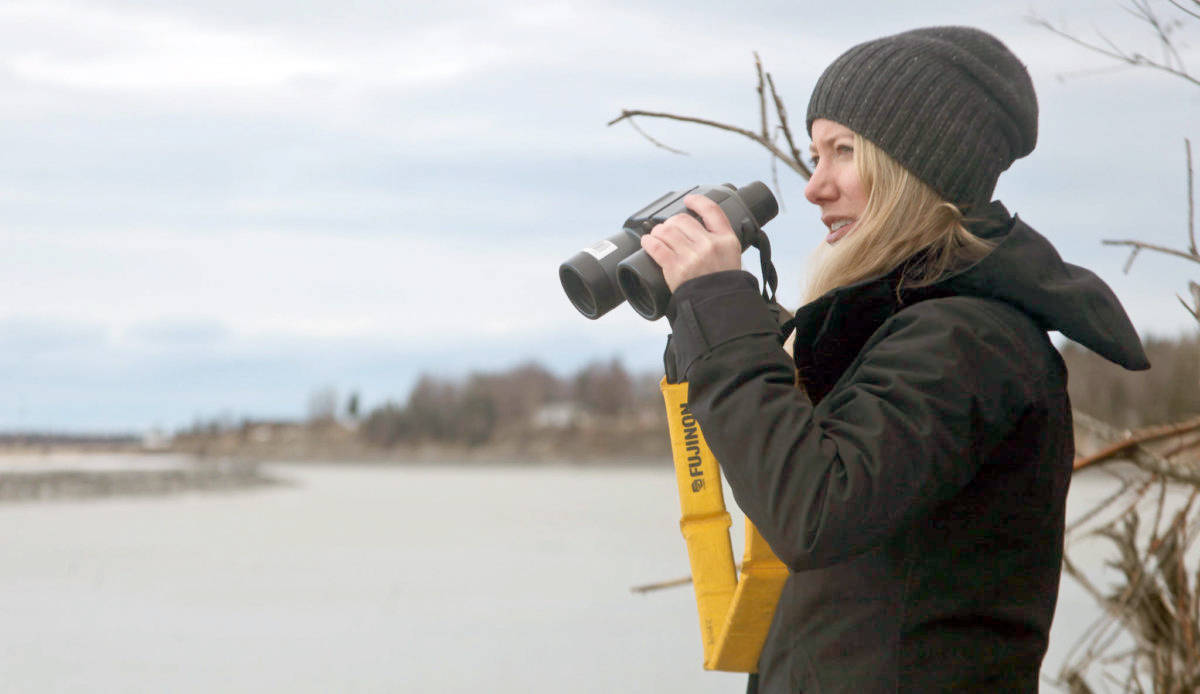The Alaska Beluga Monitoring Partnership is offering residents the opportunity to help scientists understand more about Cook Inlet beluga whales.
The partnership — a collaboration of several organizations, including Beluga Whale Alliance, Defenders of Wildlife and the Alaska Wildlife Alliance — seeks to help facilitate beluga monitoring from citizen scientists. From Aug. 14 to Nov. 15, monitoring events will take place in sites at the mouth of Twentymile River and at Bird Point near Girdwood, at Ship Creek in Anchorage and at the Kenai and Kasilof Rivers.
Kimberly Ovitz, a citizen science monitoring coordinator with the partnership, said anyone can be involved with the effort.
“You don’t have to be a scientist or a researcher,” she said. “It’s open to anyone. You don’t have to have had experience observing belugas in the past, or really any other animal. It’s really just a great opportunity for people to come out and learn more about their ecosystem, enjoy being outside and to contribute conservation recovery of this species in Cook Inlet.”
Volunteers will learn more about the Cook Inlet beluga whales and their conservation needs, receive training on how to identify and record data on beluga distribution and behavior in the field and participate in beluga monitoring sessions at one of the partnership’s sites. Data collected will be shared with researchers and federal agency personnel to inform beluga research and management. The data will also be incorporated into NOAA’s Beluga Sightings Database and Ecosystem Portal.
The Cook Inlet beluga whale population has declined by nearly 75% since 1979, from about 1,300 whales to an estimated 328 whales in 2016, according to the National Oceanic and Atmospheric Administration, the federal agency that has managed the Cook Inlet beluga population since its 2008 listing as an endangered species. According to the agency, the Cook Inlet beluga whale population is declining by 0.4% each year.
Scientists are exploring a number of factors that may be inhibiting the population recovery, including noise. Belugas have sharp hearing. They use sounds to find each other and echolocation, a series of sound signals called clicks, to find food.
“Pervasive noise throughout the year and in different locations in Cook Inlet could inhibit beluga whales’ ability to hear, communicate, and find food,” a June article from NOOA Fisheries said.
The article said scientists believe noise from a variety of human activities may be a concern for the whales’ recovery.
This year, monitoring will take place at the Kasilof River, where citizen science monitoring hasn’t existed in the past. Ovitz said the Kasilof River is an important area to build data.
“Kasilof is also this really important area that we really do not have a lot of data on, if any data at all,” Ovitz said. “We really don’t have much more information on how frequently they use that (river), outside of people calling in and reporting opportunistic sightings.”
Ovitz said that having a monitoring site at Kasilof will help fill current knowledge gaps, while also being able to learn more about how the whales use a river that has human activity going on around it.
The beluga monitoring project was originally spearheaded by Miami University graduate student Suzanne Steinert in 2017 in collaboration with the National Oceanic and Atmospheric Administration. Steinert’s project took place at the mouth of the Twentymile River at the Turnagain Arm. Ovitz was hired on as a research fellow with National Oceanic and Atmospheric Administration shortly after, and established a monitoring site at the Kenai River in the spring of 2018. Since then, both Ovitz and Stiner have been fielding monitoring efforts in those parts of Cook Inlet.
Ovitz said the project found belugas were very active in the Kenai River.
“We were seeing beluga activity in the river every day and that really affirmed that this an important feeding site,” she said. “We know it’s important for this population, which also happens to be endangered. On top of that, it’s an area heavily used by people.”
She said the Kenai River has the potential for a lot of interactions between belugas and humans, and that it’s important to know what those interactions look like and how often they’re occurring.
Ovitz said during her spring 2018 monitoring efforts on the Kenai River, she had about 10 to 12 members of the public helping out periodically. Stiner’s project at Twentymile River has about 15 to 20 volunteers. This year, the partnership was formally established after the group received funding from NOOA Fisheries to hire on a coordinator. The partnership is pushing to solidify and standardize protocols for monitoring methods, as well as increase the number of citizen scietists in the region, especially on the Kenai Peninsula.
“We’re really shooting to have this combined effort and get more people on board and really have this collaboration functioning,” Ovitz said. “We’re hoping this fall for a really big push to increasing citizen science monitoring in the area, and if things go well, we want to keep it going in future years.”
While Ovitz said every year is an important year to be watching the belugas and gathering data, this year is especially important. In May, the National Oceanic and Atmospheric Associations Fisheries announced a gray whale unusual mortality event. As of July 26, the association has reported a total of 191 whale strandings from Mexico to Alaska, with 30 being in state. The cause of the deaths is still undetermined, but several of the whale necropsy results show signs of emaciation, according to an article published by NOOA Fisheries.
“Because we’re seeing this mortality events in larger whales and in other marine animals it is really important to look at other components of this ecosystem that make up the Kenai River and Cook Inlet and try to understand how this event we’re seeing might impact other members of that ecosystem, like beluga whales,” Ovitz said.
Interested citizen scientists can find more information about getting involved in the initiative by visiting akbmp.org.

